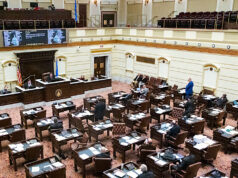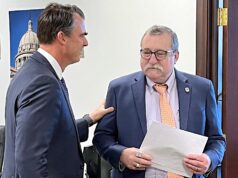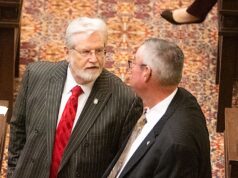
More than I’d like to admit, covering the Oklahoma State Capitol can feel like banging your head against a wall.
A week ago Friday, metaphor became reality as Capitol project manager Trait Thompson led four other curious souls and me on a fascinating tour of the building’s renovations. Scaffolding, I learned, is less friendly to the vertically inclined.
“These hardhats get scraped up,” Thompson said, referring to how often a taller person might bang their head on the framework.
I also learned a great deal about the history of the people’s building, traipsing from a mud-filled hole that will become the governor’s new private elevator to the top of the stone edifice.
“There will not be a square inch of this building that we won’t have touched by the time we are done,” Thompson told me, Corey Jager of the Oklahoma Department of Wildlife Conservation and Wendy Shreffler, Rachael Hunter and Cordon DeKock of the Oklahoma State Chamber. “We have so many moving parts in this project. (We have) to keep everyone rowing the boat in the same direction.”
That includes two general contractors — Manhattan Construction for the interior and JE Dunn Construction for the exterior — as well as numerous subcontractors.
“On any given day, I’ve usually got about 100 people working on the exterior of the building and about 200 working on the interior. Sometimes a little more, sometimes a little less,” Thompson said. “On this construction site — at least on the exterior — you will hear Polish spoken quite a bit. Most all of our stonemasons are Polish. They come from Chicago, they work here and then they go back.”

‘The masonry was really cool’
The masonry work being done is quite impressive, and Thompson listed the process for its cleaning: 1) power washing, 2) steam cleaning and 3) microabrasion.
As I tried to keep from ramming my noggin into parts of the scaffolding, we watched a man named Jarek Sienkiewicz grind a new piece of stone to match the curve of an older one just outside the office of Sen. J.J. Dossett (D-Owasso).
“You have to make sure the Legislature is happy,” Thompson had said earlier on the tour before elaborating on the scaffolding. “The biggest challenge is that we are very close to where people are working inside their offices. We have to use hand tools to grind all these joints, and it’s loud. It presents a lot of dust, so we have dust that gets into offices. We’re just hoping the tenants are patient with us and understand, and when we make a mess, they let us know and we clean it up.”
On our way to the roof of the building, we discussed the masonry work at length, including the restoration of damaged eagle sculptures.
“I thought the masonry was really cool — how intricate that is and how most of them are from Poland and how it’s a specialized trade,” Hunter told me. “I think it’s just really interesting to see what’s original, what they’re able to preserve.”

This is what $1 million looks like
With a budget of more than $240 million, the Capitol restoration project is expected to run through 2022, updating everything from the building’s bones to its brain.
“We’re doing open-heart surgery on a guy jogging on a treadmill, and he can never stop jogging,” Thompson said, perhaps metaphorically inspired by the Capitol gym that used to be its smoking room.
To that end, Thompson took us to the “electrical brain of the building.”
“Everything is consolidated now,” he said, noting that the room alone features 70,000 pounds of new electrical wiring. “Our entire electrical infrastructure in this building was unreliable.”
Indeed, the Oklahoma State Capitol never had a backup generator until renovations began. Called “The Green Beast,” the natural-gas-powered emergency generator solves “a lot of big problems,” according to Thompson.
“If you ever wanted to know what $1 million looks like, this is it,” he said. “This was custom-built for the building. You don’t go to Walmart and pick one of these up.”

Thompson: ‘This is going to be a source of pride for Oklahomans’
A native of Michigan who serves as the legislative liaison for the Oklahoma Department of Wildlife Conservation, Jager said she enjoyed learning more about Oklahoma’s history on the tour.
“It was cool to see some background history of the building but also get up and close to some of the fine details I never have the time to look at,” she said. “Of course, getting to the top of the Capitol is probably something I’ll never get to do again.”

Thompson said he believes the renovated Capitol will be a source of pride for Oklahomans.
“When we went to Kansas and visited with state officials there after they had completed their Capitol restoration, we asked the Kansas speaker of the House why it was important for them to do this project,” Thompson said. “He told us, ‘Our Capitol is our front door to the world. It is the first impression that someone sees of our state.’
“So when somebody had come to the Oklahoma Capitol before, it didn’t leave a good impression of us. By completing this project, this is going to be a source of pride for Oklahomans. This is the No. 1 tourist destination in the state. So when people come to this building and they see it restored and they see the beautiful art and they see how much pride we take in our Capitol building, they are going to see the pride we take in ourselves as Oklahomans.”
One feature of the Capitol that could draw international attention down the road is a part of the project that currently lacks funding: carving the triangular pediment above the building’s front steps.
“The triangular pediment up there was always meant to be carved. It’s a relief like you would see on the front of the U.S. Supreme Court and many other notable buildings,” Thompson said, saying that carving it would cost another $2.5 million to $5 million. “We don’t have money in the project to do that, so we would have to raise funds privately, but it’s something that I would like to see done in order to complete that artistic vision of the Capitol building.”
Thompson said early discussions about the pediment had “stone carvers coming out of the woodwork” because it would be “a legacy project.”
“Based on research that the Arts Council did, the last pediment-relief carving to be done was the U.S. Supreme Court building in the 1930s,” Thompson said. “You would have to hire a master stone carver to do it, and not every carver is qualified to do that work.”

360 images of the Capitol restoration
Click the three dots in the top right of the image viewer below to enter full-screen mode. These 360 images may load best on desktop, laptop or tablet.




















